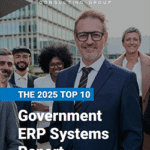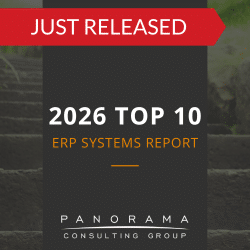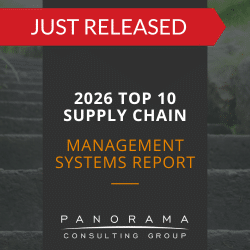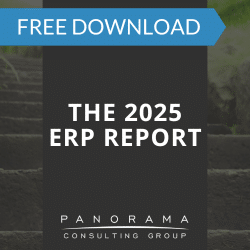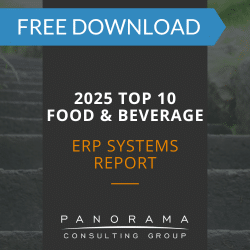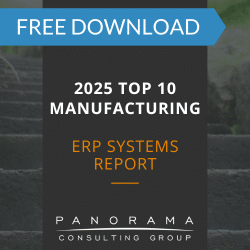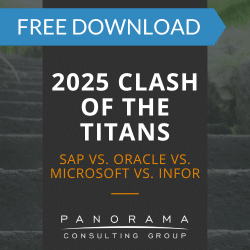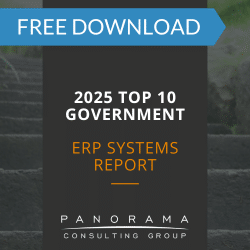- ERP project resource constraints often originate in early phases but create cascading post-go-live risks that impact adoption, data integrity, and operational performance.
- Common ERP project staffing issues include overloaded internal SMEs, insufficient testing capacity, and lack of ownership for cross-functional decisions.
- ERP implementation resource shortages can result in hidden technical debt, causing ERP failures that surface only after the system is live.
- To avoid these pitfalls, organizations should work with an independent ERP consultant to align staffing and plan phased rollouts.
In many organizations, ERP project resource constraints begin during early phases, like requirements gathering and configuration, but their consequences stretch far beyond go-live.
Executives leading ERP transformations should treat resource allocation as a strategic variable. Underestimating the scope of effort required by both internal and external resources introduces a hidden form of operational and technical debt. When project teams are stretched too thin, quality suffers quietly, until the system is live and issues begin surfacing faster than they can be resolved.
Today, we’ll examine how these early resourcing gaps take shape, why they matter after go-live, and what executive teams can do to prevent ERP project staffing issues from undermining business outcomes.
A Failed Payroll System Implementation
Panorama’s Expert Witness team was retained to provide a forensic analysis and written report to the court regarding the failed implementation of a major software developer’s ERP/payroll system.
The Hidden Risk in Understaffed ERP Projects
Organizations often assume the heavy lifting will be handled by the implementation partner. However, the reality is that successful ERP implementation demands deep internal involvement. The knowledge required to configure, test, and validate the system sits within the business, not the vendor.
This is where early ERP project staffing issues emerge. Internal subject matter experts are asked to contribute to design workshops, review integrations, and test workflows—yet they are still required to perform their day jobs.
Over time, quality slips. ERP projects may proceed with assumptions that go unchallenged simply because no one had time to push back.
For example, a public-sector organization encountered serious challenges when critical business requirements were missed early in an HRMS implementation. The lack of internal oversight and resource bandwidth during the design and configuration stages led to major integration gaps and a fragmented system architecture.
Panorama’s project assessment revealed that the delivered ERP software could not meet several key requirements without costly customization. This limitation could have been identified earlier had the internal project team had sufficient bandwidth.
This is a classic example of how ERP implementation resource shortages early in the process create downstream complications that cannot be “patched” after go-live.
How Resource Constraints Erode Post-Go-Live Stability
When ERP failures surface after launch, the root cause often traces back to missteps during design, testing, or change readiness—all functions that require time and dedicated staffing.
Here are three common ways early resource constraints evolve into post-go-live issues:
1. Incomplete Testing Leads to Functional Gaps
Without full participation during scenario-based testing, some use cases may be missed.
For example, a distributor might fail to simulate drop shipments across international suppliers. While the ERP system technically “works,” it would break in real-world usage, leading to customer service breakdowns.
2. Change Saturation Limits Adoption
Without resourcing internal change agents in each department, communication becomes top-down and transactional. Users may feel unprepared, adoption suffers, and eventually, teams revert to manual workarounds.
3. Vendor Oversight Goes Unchallenged
When internal resources are stretched, they default to vendor-led timelines and design decisions.
For example, SCM vendors sometimes push templated configurations, and without internal oversight, the final build may optimize for this simplicity rather than strategic fit.
Why Executives Should Pay Attention
Resource gaps are often framed as HR issues. But from a C-suite perspective, they should be treated as enterprise risk. ERP software connects your supply chain, financials, customer interactions, and human resource processes. Misalignment at the staffing level creates ripple effects across the entire operating model.
Consider these high-impact questions:
- Who owns process decisions across order-to-cash or procure-to-pay workflows?
- Are internal SMEs truly empowered to push back against ERP consultants and integrators?
- Has the project team factored in the backfill or role coverage needed to keep business operations stable during the implementation?
An ERP project resource constraint reflects gaps in organizational readiness and strategic clarity. When leaders underinvest in strategic alignment, they often incur significantly higher costs in remediation, rework, and delayed value realization.
Strategic Recommendations to Prevent Resourcing Gaps
As an independent business software consultant, we advise clients to front-load resource planning with the same rigor as system selection. Here are five strategies we recommend:
1. Conduct a Role-Based Resource Assessment During Planning
Define required roles by workstream—data, testing, reporting, process design, change leadership—and assign accountable owners. Use a heatmap to identify gaps and overlapping demands. Then, build your ERP software list with staffing requirements in mind, not just features.
2. Establish Dedicated Project Time for Internal SMEs
Treat ERP as a strategic initiative, not a side project. We suggest allocating 30–50% of select internal team members’ time for the duration of the implementation.
For highly involved roles, full-time dedication may be required. This may require backfilling operational duties temporarily.
3. Prioritize Use Cases with Business Value and Resource Feasibility
Use value vs. readiness scoring to phase system enhancements responsibly, rather than overloading the team in early phases.
For example, some AI in ERP use cases require high-quality data and business alignment. This means organizations must ensure they have dedicated internal experts and technical support available before attempting to implement these advanced features.
4. Embed External Experts Where Internal Capacity is Thin
In cases where internal expertise is limited (e.g., multi-entity consolidation or advanced supply chain planning), bring in a qualified ERP consultant to support the team. These experts should work alongside internal staff to transfer knowledge, guide decisions, and build internal capabilities. The goal is to strengthen your team, not to hand over control.
5. Align Project Milestones with Operational Cycles
Manufacturing, distribution, and supply chain-heavy organizations often face tight seasonal or fiscal cycles.
Regardless of your industry, project timelines should flex to avoid year-end closes, audit windows, or peak production months. This preserves resource capacity and lowers the likelihood of burnout.
Why This Matters Beyond Go-Live
Resource constraints during ERP projects cascade into adoption gaps, workarounds, and ultimately lost ROI. Even with access to the most popular ERP systems, success hinges on execution quality, and that depends on having the right people involved at the right time.
Three long-tail risks are especially important:
- Financial Exposure: Budget overruns caused by emergency remediation, additional vendor support, and unplanned system rework often dwarf the original savings from lean staffing models.
- Talent Drain: Teams pushed too hard during implementation frequently disengage after go-live, leaving a vacuum of system knowledge and weakening internal ownership just when stability matters most.
- Diminished Leverage: Once the system is live, your dependency on vendors increases. If your internal team is under-resourced or burned out, it becomes harder to negotiate changes, escalate issues, or drive improvement on your terms.
To avoid these pitfalls, executives should treat ERP project staffing issues as a strategic variable, not a fixed constraint. Proactive planning, phased implementation, and cross-functional ownership create the conditions for a stable launch and long-term system performance.
Learn More About Post-Live Problems
ERP implementation is an enterprise transformation that tests your organization’s ability to align people, processes, and data. Resourcing is where that alignment becomes visible.
Before committing to any major ERP system, executives should pressure-test their internal capacity alongside their technical requirements.
As an independent ERP consultant, we can help your organization evaluate your resourcing readiness and ensure your ERP investment translates into measurable value. Contact our enterprise software consulting team below to learn how to de-risk your implementation.


